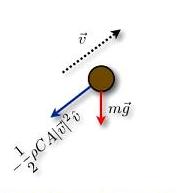
Home
Punting
Tackling
Blocking
Bibliography
Physics
Involved
in
Throwing
the
Football
http://www.robbinssports.com/sporting-goods-store/images/footballs-robbins-sports.jpg
An American football is shaped like
an egg, or ellipsoid. Therefore, it cannot be thrown like a spherical
object to
achieve maximum distance. It is actually thrown horizontally, axis
parallel to
ground in the long direction, in order to “slice” through the air, this
in turn
reduces the cross sectional area in which air resistance can affect the
ball. In
addition a rotational component is applied to the ball to reduce air
resistance
and maximize distance. When an individual throws a football the flight
path of
the given projectile is that of parabolic motion. The football is then
independent of an applied force after the initial force is applied to
the
football. The football is then only affected by gravity, air
resistance, and
rotational inertial energy. A football’s vertical component is affected
by
gravity and the angle of attack of the air resistance on the ball. Gravity is a
constant and the air resistance is taken to be a constant throughout
flight,
but the rotational inertial energy decreases as soon as the ball is
released.
The rotation of the football causes it to slice through the air, if not
enough
force is applied the ball will begin to unravel if you will. This
results in a
greater cross sectional area and greater air resistance on the ball.
These all
affect the flight path of the ball, and simple physics explains all of
these
components. Just like it
Gravity is a
constant and the air resistance is taken to be a constant throughout
flight,
but the rotational inertial energy decreases as soon as the ball is
released.
The rotation of the football causes it to slice through the air, if not
enough
force is applied the ball will begin to unravel if you will. This
results in a
greater cross sectional area and greater air resistance on the ball.
These all
affect the flight path of the ball, and simple physics explains all of
these
components. Just like it
can also explains the how one punts a
football.
http://blog.dotphys.net/2008/12/throwing-a-football-part-ii/